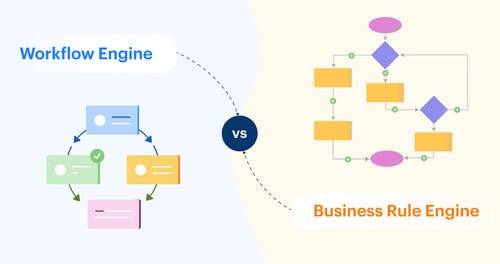
- >
- Workflow Platform >
- Is a Workflow Engine Software the Same as a Business Rule Engine?
Is a Workflow Engine Software the Same as a Business Rule Engine?
Many people think that a workflow engine and a business rule engine are the same. Some even use the terms workflow engine and business rule engine interchangeably. But they are actually quite different terms, and you can run into a lot of headaches if you don’t know which one you are looking for.
What is a Workflow Engine?
A workflow engine is a fundamental component of task distribution software, such as business process management systems, that assigns tasks to various executors while facilitating data exchange among participants, thereby streamlining and automating complex workflows.

Let’s clear the fog around the two terms by looking at some real-world differences in their usage.
A workflow is a series of tasks that process data to a finished state. It’s a time-bound workflow orchestration of tasks that are repetitive and predictive in nature.
When you buy a pair of jeans from your favourite online store, it kickstarts a workflow involving payment processing, order fulfilment, and dispatching to delivery.
Streamline Your Business Process Workflows
Most workflows are manually completed and carried out through email or paperwork for approval. But in recent years, modern businesses have used workflow software to automate their workflows for speed, accuracy, and cost efficiency.
Most of these workflow tools come hard-coded with a process designer, a feature that allows software users to run a workflow instance without coding. The workflow designer lets the admin route tasks in a linear sequence, assign tasks dynamically depending on data in the form, and add conditions, exceptions, parallel branches, etc.
So where does the workflow engine come in?
In this context, workflow engines are pre-coded script that takes account of a workflow design, i.e. how tasks should flow from one stage to another, and executes the step. A workflow engine is a code embedded in the software that pushes a task from one stage to another.
Notice that the workflow engine doesn’t influence ‘how’ a workflow should take place, but takes its cue from the design and runs the tasks.
Benefits of Workflow Engine for Businesses
The gains of workflow engines are numerous, facilitating your business to be efficient overall. It ensures that your workflows are completed faster and better giving a positive impact on your bottom line.
Workflow engines offer businesses significant advantages such as automating processes, improving efficiency, reducing errors, and more. Lets check some of the benefits
- Boosts Efficiency Through Automation: Automates repetitive tasks, streamlines processes, and reduces manual effort—leading to faster completion times and improved productivity.
- Improves Accuracy and Reduces Errors: Standardizes workflows and automates data handling, minimizing human errors and ensuring consistency and data integrity.
- Enhances Visibility and Accountability: Provides real-time process tracking, audit trails, and clear role assignments, making it easier to monitor progress and ensure accountability.
- Reduces Costs and Optimizes Resources: Cuts operational costs by eliminating inefficiencies, improving resource allocation, and reducing wasteful activities.
- Scales Easily with Business Growth: Adapts to increasing workload and complexity, making it suitable for growing organizations looking for sustainable process management.
- Improves Collaboration and Compliance: Offers a centralized platform for team collaboration and helps enforce compliance with industry regulations through automated checks.

Many organizations often suffer from various confusion such as:
-
Who’s responsible for this task?
-
Why is my reimbursement request taking so long?
-
Why isn’t the document approved yet?
-
Where’s the document I asked for?
-
Wait, am I supposed to do that?
-
Oh sorry, I might have missed the email!
And so on. The right workflow engine gives complete transparency to each task, making it easy for everyone to be accountable for their work and deadlines.
-
Workflow engines facilitate the seamless flow of data, documents, tasks, and events.
-
Everybody has visibility to the task information making it easy for them to complete the activities on time.
-
Operational bottlenecks can be easily identified and eliminated since each task and process is transparent.
-
Legacy systems like emails, papers, and memos are massively reduced, thus saving money and resources, while ensuring that no data is lost.
Example of workflow engine - Common use cases
Employee Onboarding:
It is reported that 58%[1] of organizations say that their onboarding programs are focused on processes and paperwork, making it informal, inconsistent, and complex.
The more an organization relies on manual employee onboarding processes, the more frustrating the employee’s experience will be. With the help of a workflow engine, each onboarding task is guaranteed to be carried out smoothly.
All the steps right from employees uploading the documents to computer access granted by the IT department are automated. This way, no steps are missed, and the employees are provided with all the necessary items to get started.
Approval Management:
As your organization expands on one side, approvals can be very hard to manage manually. When approval requests are sent and tracked via emails, it can get cluttered, easily frustrating the employees. Also, important approval documents can get lost in the lengthy mail trails, putting the organization at risk. A workflow engine helps eliminate all the chaos by streamlining the approval process. Anyone involved in the process can seamlessly manage and track the progress of each task. Since the process is aligned, the task is automatically pushed to the next concerned person, ensuring faster completion of tasks.
⋙ Check out Approvals Made Simple with Kissflow Workflow
What is a Business Rule Engine?
A business rule engine is a set of conditions in a software that executes an application code if all (or a specified number of) conditions are met. It is about setting criteria for how a software should behave within certain parameters.

The advantage of a rule engine is that it enables non-technical software users to change the software behavior based on their business requirements without having to change the underlying codes. They make decision-making quick and reliable based on a multitude of facts that is too large for humans to process through.
Business rule engines (referred to as BRE in enterprise parlance) are part of a broader concept that finds its scope outside of workflow management (workflow manager). Rule engines have no control over orchestrating tasks; they work as a guideline for software to infer decisions based on certain criteria. It can be used to emulate a workflow process given the conditions.
Here’s an example of how an e-commerce website can have one of the following rule engines applied to its payment gateway:
-
Apply 15% youth discount on the item if the buyer enters age 18 to 29.
-
Apply 20% discount on the item if the buyer chooses his age >59.
-
Apply no discount on the item if the buyer chooses age between 30 to 59.
A set of business rules engines combined together is called a ruleset; they are often represented in tabular form or a decision tree. Enterprise software uses business rule engines mainly to ensure operational consistency. Whether you're an IT Leader, Developer, Process Owner, or Business Manager, low-code is transforming the way enterprises build applications.
Benefits of Business Rule Engine for Businesses
Business rules engines deliver significant advantages such as increased efficiency, greater agility, and consistent decision-making — helping businesses accelerate time-to-market, ensure better compliance, and lower operational costsCheck out the key benefits below to know more.
- Drives Efficiency and Cuts Costs: Automates decision-making and streamlines processes, reducing manual errors, improving productivity, and lowering operational costs.
- Boosts Agility and Time-to-Market: Enables quick updates to rules without changing code, helping businesses rapidly respond to market shifts and launch changes faster.
- Ensures Consistency and Compliance: Centralized rule management ensures uniform rule application and supports regulatory compliance by minimizing manual intervention.
- Improves Accuracy and Reduces Errors: Automated decision logic reduces human errors, ensuring more reliable and consistent outcomes across operations.
- Scales with Business Growth: Easily manages a growing volume of rules and decisions without demanding heavy infrastructure or IT resources.
- Empowers Business Users and Enhances Integration: Allows non-technical users to manage rules independently while integrating seamlessly with existing systems to improve customer experience
One of the biggest advantages of the business rules engine is that the updates made to the rules need not be made to the rest of the application code as well. This helps the developers maintain their applications hassle-free and flexible as the requirements of the business change. The risk and cost of updating the application are significantly reduced, thereby freeing up the resources that can be instead used to innovate other business elements.
The load balancing feature of a business rules engine enhances the scalability of an application by unloading the execution of rules to multiple servers. This empowers the primary webserver to handle more volume of requests efficiently.
Since the programming language is replaced with logical rules and decision tables, it enables you to develop logic without the need for complex coding.
Workflow Engines Vs Business Rule Engines
A workflow engine and a business rule engine both allow non-techy end-users to change a process behavior at runtime without the need to change the code.
Learn the difference between a workflow engine and a business rule engine in workflow software.

But they have more differences than similarities. As mentioned above, they are fundamentally different in their working and purpose.
Listed below are a few more differences between a workflow engine and a business rule engine:
Workflow Engine |
Business Engine |
| Based on process | Based on rules |
| Specific to a workflow | Enterprise specific |
| A program designed to run workflow instances based on the process model | A program designed to help with complex decision-making |
| Inherent driving force in an automated workflow | Works as a pluggable element that could be separated from the application code |
| Help with carrying out a business process | Help with creating business knowledge |
The Conclusion
An organization, to function efficiently, will require both a workflow engine and business rules engine. Although it is easy to mix up and assume both serve the same purpose, they are wildly different concepts with different motives. It is important to seek the best workflow engine while looking for a workflow software. Solve your workflow challenges with Kissflow Platform and optimize your team's productivity.
If you have decided to go with the workflow engine and want to take the plunge into workflow automation, make sure to sign up and start a free trial by visiting Kissflow Workflow. It is your go-to process automation platform designed to effectively streamline your workflows of various processes, giving you the agility and flexibility to run your business operations hassle-free.
FAQ:
1. What is the difference between a workflow engine and a business rule engine?
A workflow engine automates and manages sequences of tasks or business processes, guiding the flow of work across teams or systems. In contrast, a business rule engine makes decisions within those workflows based on predefined rules, without changing the underlying code.
2. When should you use a workflow engine vs a business rule engine?
Use a workflow engine when you need to orchestrate multi-step processes across departments. Use a business rule engine when decisions must adapt frequently based on dynamic business logic or compliance rules.
3. Which is better for automation: workflow engine or business rule engine?
Both are powerful automation tools. Workflow engines handle task flow and coordination, while business rule engines ensure smart decision-making within workflows. For end-to-end automation, using both is ideal.
4. What are some examples of use cases for workflow engines vs business rule engines?
Workflow engines are used in employee onboarding, purchase approvals, or claims processing, where multiple steps are involved. Business rule engines are ideal for credit scoring, insurance underwriting, or pricing models, where rules change often
Streamline Your Workflows with Kissflow
“Creating workflows is significantly easier here than in other products. We have been able to successfully distribute the work to create workflows because of Kissflow”
- Ryan H
Thanks for submitting.
Our solution experts will connect with you to get started.
Related Articles











